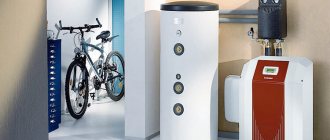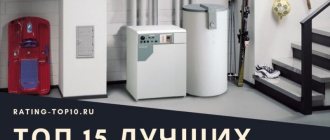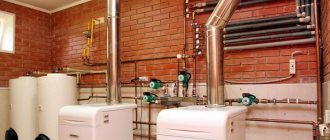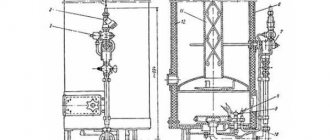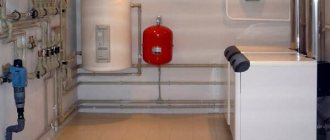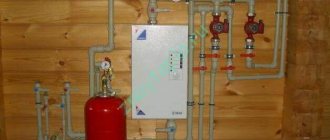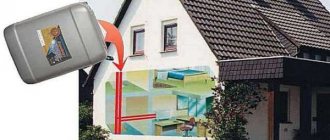Home / Electric boilers
Back
Published: 06/08/2019
Reading time: 6 min
0
2108
A growing number of social green movements around the world are demanding that governments pay due attention to environmental issues in their life support systems. In response to their demands, as an alternative to stove heating, models of economical electric boilers for heating a private home were released onto the market.
- 1 How relevant is the method of heating with an electric boiler?
- 2 Advantages of electric boilers
- 3 How to choose a good electric boiler 3.1 Power
- 3.2 Energy efficiency
How to choose an electric boiler
Choosing an electric boiler requires a thoughtful approach.
It is necessary to take into account the area of the heated room, correctly calculate the required power, select the optimal installation option to save space. It is also important in the region with what climate the equipment will be used, and what the house is built from.
To figure out how to choose an electric boiler for heating a private home, you need to consider in detail the most important characteristics:
Thermal power. Heating intensity indicator. Roughly calculated as 1000 W per 10 sq. m heating. To make an accurate calculation, it is necessary to take into account the regional coefficient, which corresponds to the climate zone, the height of the ceilings (if above 2.7 m, the heated footage is reduced), and the amount of thermal insulation of the walls. 100 W should be added for each window, and another 200 W for entrance doors. The result obtained is multiplied by 1.5 to level out heat loss through the walls and ceiling.
Equipment. A good boiler is equipped with a circulation pump, a tank for expansion of the coolant, fasteners, a sensor, and protective options. For cheap devices, you often have to buy everything separately, which ultimately significantly increases the final cost.
Adjustment. Either step control or smooth control is used. The latter is more preferable, it allows you to more accurately regulate the heating.
Control. Mechanical and electronic are used. The first is cheaper and more reliable. But their adjustment is quite rough, often in steps. Electronic is better - it allows you to accurately adjust the heating temperature and is able to maintain a given range.
Remote control. A convenient option, especially in cases where the heater is located in the basement or boiler room. Allows you to make settings remotely. Some electronically controlled boilers can even be configured via the Internet from another country - this is important for people who travel frequently.
Frame. Closed is preferable to open. It is more correct to buy one in families with children - it is a guarantee of safety.
Built-in circulation pump. Allows you to quickly warm up the system. It also increases the pressure in the pipes, which makes it possible to heat a house with several floors. If not included, the pump will have to be built in separately.
Expansion tank. Needed for heated coolant. The built-in tank simplifies installation of the system. If not included, you can purchase it separately.
Second circuit. A heater with two circuits can be used to heat the water needed in the household; there will always be a hot flow. But such boilers are very expensive; it is often more rational to purchase a separate water heater - it will be much cheaper.
Brands. Electric heating boilers are produced by many companies, both well-known and new ones.
The boiler requires reliability and safety, so it is better to pay attention to reputable brands. The best manufacturers of electric boilers: German Bosch, Vaillant, Slovakian Protherm, Protherm, Belgian ACV, South Korean Navien, Russian EVAN, ZOTA.
No. 6. Power regulation and boiler control system
In electric boilers, it is enough to simply regulate the power and temperature of the coolant. Actually, these two parameters are interrelated, so it is impossible to consider them separately from each other.
The boiler power is adjusted in one of the following ways:
- stepwise - a common option in heating element boilers. In this case, the design provides one heating element, which provides half the power, and two, which provide 25% heating each. It turns out that the boiler can operate at 25, 50, 75 and 100% of the maximum power; more precise adjustment can be made in each room thanks to the valves on the radiators;
- Smooth adjustment is achieved through the use of a rheostat. This is a privilege of more expensive models. In simple low-power boilers there may be no adjustment at all.
The user sets the boiler the required coolant temperature to maintain comfortable conditions in the house, and the boiler turns on the heating and turns it off when the coolant is sufficiently hot. Automation can work using mechanical and electronic thermostats. Both options allow you to save energy and maintain a comfortable temperature without constantly monitoring the boiler.
A mechanical thermostat cuts off the coolant flow or opens the electrical network when the user-specified coolant temperature is reached. When the temperature drops, the boiler turns on again. This is a simple and cheap method, but not the most accurate - the coolant temperature at the boiler outlet may differ by 2-30C from the set one. Electronic thermostats are more accurate; they consist of a remote sensor and a control unit. The sensor is attached to the heating element and transmits information about its temperature to the unit remotely or using wires. Naturally, such boilers are more expensive.

Economical models of electric boilers with high efficiency
For home heating, most people purchase heating element boilers. They are the least hassle and are much cheaper than induction or electrode. In addition, the electrode will have to be replaced frequently, which is not very profitable. Among the boilers with an electric element, we can highlight the equipment “KOSPEL EKCO”, manufactured in Poland and having an efficiency of more than 99%. This boiler is used for radiator heating. It can also be used in conjunction with a water heater to provide hot water to the home.
Boiler energy savings occur due to the multi-stage nature of the device. For models with power over 50 kW, three-phase installations are provided. There are 2 operating modes available - manual and automatic. The latter is good because special software sets the required temperature, which changes depending on the time of day. The only drawback common to all boilers of this type is the periodic appearance of scale. If it is not removed, the performance of the device will decrease significantly.
electric boilers
Electrode boilers are less popular among the population. However, in terms of their efficiency, they demonstrate high performance. For example, they “eat” 2 times less kilowatts than the same heating element heater, while heating a much larger area. The ability to save energy when using such boilers is achieved thanks to modern technologies. The water in an electrode boiler is heated without additional equipment (for example, a thermal element or induction coil), so less energy is consumed.
The operation of the electrode boiler is accelerated due to a smooth start and modern automation. Among electrode boilers, one of the most popular is the “Geyser” with a capacity of 9 to 15 kW of domestic production, the cost of which is about 12 thousand rubles. Moreover, the price range of such equipment varies from 3.5 to 15 thousand rubles. The line of these products also includes “Ochag” boilers, which are less powerful than “Geyser”. And Vulcan boilers are the most productive, their power reaches 50 kW. All boilers from this manufacturer operate silently and have high productivity (from 98%).
These models have all the above advantages of an electrode boiler. The main disadvantages that make many people afraid to purchase innovative electrode cats is the risk of electric shock. In addition, an emergency shutdown setting cannot be used for such a unit. If you need to replace the electrode, you will have to constantly seek the help of professionals.
Among the induction heating boilers, we can highlight the “SAV” brand, produced domestically by the scientific company INERA. THEIR products have a fairly high price (from 30 thousand to 160 thousand rubles). The cost depends on the power of the purchased boiler (from 2.5 to 100 kW) and the expected heating area. But at the same time it has a number of advantages. The efficiency of the electric boiler of this company is 99 percent. It is equipped with a starting (automatic) relay. The operating principle is the same as that of conventional induction units.
Types of electric boilers
When choosing an electric boiler, you must remember that behind the same housings in the same price segment, the equipment has a different operating principle. This affects the internal structure, efficiency, performance, safety, durability and other parameters. Let's get acquainted with the types of electric boilers.
New heating element
The design of an electric boiler with a thermal electric heater (TEH) provides for the presence of a heating coil. This element, which performs the main functions, is placed in a heat-conducting tube. This is the most popular type of boiler units, as it is simple, safe and affordable.
The main feature of operation is the likelihood of scale formation on heating elements, as a result of which they begin to overheat and fail. Basically, a similar situation occurs in supply-type heating systems, when water is constantly drawn from the circuit. Therefore, choose a boiler of this type with a closed loop, which will avoid the problem.
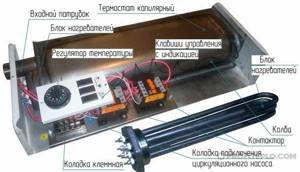
Internal structure of a heating element boiler
Heating element boilers are suitable for systems where automation is responsible for regulating the pressure, since in case of failure the unit turns off.
Induction boiler
The transformer coil is what this heating device is. The device is powered through the primary winding, which is connected to the mains. The presence of a secondary winding is necessary to generate an alternating magnetic field. As a result, eddy currents appear on the metal tubes placed inside. They are responsible for heating the coolant moving along the circuit.
Main advantages
:
- The most compact size among analogues.
- Exceptional reliability: The primitive design prevents malfunctions.
- The ability to simultaneously use several devices at once to increase the overall power of the system.
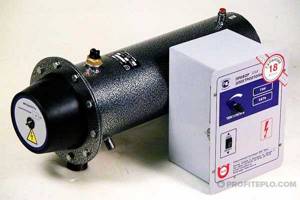
Induction electric boiler
Electrode boiler
Some of the heating equipment on the market are electrode boilers. These devices require electric current to heat and ionize water molecules. Features of operation include the use of pre-prepared (purified) coolant. Such electric boilers cannot be installed on circuits with ordinary water.
This is the safest type of electric boiler: water heating stops if the integrity of the circuit is damaged. A nuance of operation is the need to periodically replace the electrode elements.
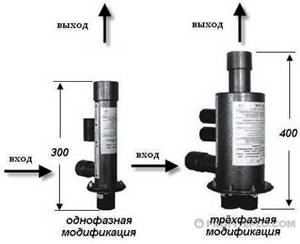
Types of electrode boilers
The most economical EVAN WARMOS-M 30 30 kW
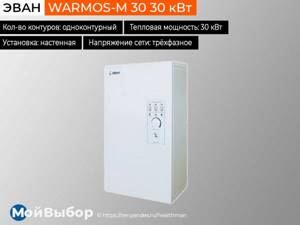
It was included in the rating of electric heating boilers for private homes as the inexpensive and most economical electric boiler. Efficiency is achieved due to an efficiency of 99% and heating of the coolant within the range of 5–85 degrees. This allows you to select heating at the minimum temperature in case of slight frosts. Wall installation, dimensions – 380x640x245 mm, device weight – 27 kg.
In the southern regions, the device is enough to heat a house up to 300 square meters. m, in more northern regions it is better to install it in a house up to 200 sq. m. m. The unit is smart, electronically controlled, diagnoses itself, showing fault codes on the display.
Convenient as a main heating unit and as a backup unit. It is especially effective when setting the minimum positive temperature at home when the owners are absent.
Pros:
- power – 30 kW;
- wide range of heating temperature adjustments;
- Efficiency – 99%;
- economical;
- large heating area.
The whole truth about the electrode boiler.
Heating element electric boilers In boilers of this type, tubular heating elements (heating elements) are used to heat the coolant.
The boiler has a lot of protection: From freezing of the coolant; From freezing of an indirect heating boiler; Pump protection against jamming; Safety valve 3 bar. Induction boilers There are interesting parallels between household appliances in the kitchen and types of electric boilers. The disadvantages are still the same: Hard water deposits sediment; Serious protection against coolant leakage is required. Design of an induction heating boiler Let's look at the design of an induction heating boiler using the example of the SAV induction boiler.
No. 1. Advantages and disadvantages
An electric heating boiler works extremely simply. In it, electrical energy is converted into thermal energy. When the boiler is turned on, the heating elements heat the coolant. The latter enters the living space through a system of pipes and radiators and heats the air in it. In the simplest and most common version, the usual heating element is used as a heating element, but there are also induction and electrode boilers in which heating is carried out somewhat differently. The only thing that remains unchanged is the power source – electricity. Many boiler models are equipped with a monitoring and control mechanism.
Despite the fact that electric boilers can hardly be called an economical source of heat, they are very popular, and there are many reasons for this. The advantages of electric heating boilers include:
- versatility. The unit can be installed wherever there is electricity; no permits from technical supervision authorities are required. Today, electric boilers are used both in private homes and apartments, as well as in commercial and industrial premises;
- low cost compared to gas and solid fuel boilers;
- high efficiency, which reaches 95-99%;
- ease of installation. Electric boilers are small in size, and when connecting them there is no need to build a chimney;
- ease of operation and temperature adjustment. Most models are equipped with convenient control systems and thermostats, so the user just has to press a few buttons or turn a lever - he won’t have to constantly run to the boiler, control its operation, or, worse, add fuel. Since the boiler perfectly controls its operation, its efficiency increases;
- safety. There is no open fire in electric boilers, and no flammable fuel is used. Plus, well-thought-out automation is used, so the likelihood of emergency situations compared to other types of boilers is sharply reduced, if, of course, the installation was carried out correctly;
- compactness, so installation of such a unit is possible even in the smallest rooms;
- environmental friendliness, because no harmful emissions are generated during boiler operation;
- noiselessness;
- no need for constant monitoring of operation (you can leave the boiler unattended) and frequent maintenance. Solid fuel boilers, for example, require constant care and cleaning;
- a wide range of. There are models on the market with different power (from 2 to 60 kW or more) and functionality (single-circuit and double-circuit).
There are also disadvantages:
- high cost of operation. Despite advanced automation and energy saving systems, electric boilers are still quite expensive to operate. In most cases, it is not profitable to use them for heating large rooms. Often such boilers are used as a backup heat source;
- dependence on the availability of electricity. If the region experiences frequent power outages, then this heating option is not suitable;
- the need for special three-phase wiring if a boiler with a power of more than 12 kW is used. Some experts recommend using a line with three phases even when connecting a boiler from 6-7 kW.
Despite the existing disadvantages, electric boilers find their buyers. Moreover, if you carefully analyze the conditions at the site where you want to create a heating system and choose the right electric boiler, you will be able to enjoy the positive qualities of these devices to the maximum.
No. 3. Connection type
Before purchasing a boiler of a certain power, you need to find out the features of the electrical wiring in the house. Among boilers with a power of up to 10-12 kW, you can find models that can be connected to both single-phase (220 V) and three-phase networks (380 V). It will not be possible to use more powerful boilers with a single-phase network - you will need to connect the house to a three-phase network.
To connect the boiler to the panel, it is better to use a stranded copper wire, which, with higher conductivity, will heat up less.
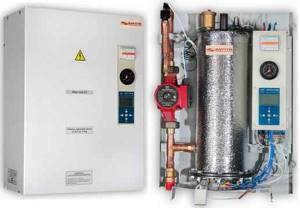
How to choose an electric boiler
Choosing an electric boiler requires a thoughtful approach. It is necessary to take into account the area of the heated room, correctly calculate the required power, and select the optimal installation option to save space
It is also important in the region with what climate the equipment will be used and what the house is built from.
To figure out how to choose an electric boiler for heating a private home, you need to consider in detail the most important characteristics:
Thermal power. Heating intensity indicator. Roughly calculated as 1000 W per 10 sq. m heating. To make an accurate calculation, it is necessary to take into account the regional coefficient, which corresponds to the climate zone, the height of the ceilings (if above 2.7 m, the heated footage is reduced), and the amount of thermal insulation of the walls. 100 W should be added for each window, and another 200 W for entrance doors. The result obtained is multiplied by 1.5 to level out heat loss through the walls and ceiling.
Equipment. A good boiler is equipped with a circulation pump, a tank for expansion of the coolant, fasteners, a sensor, and protective options. For cheap devices, you often have to buy everything separately, which ultimately significantly increases the final cost.
Adjustment. Either step control or smooth control is used. The latter is more preferable, it allows you to more accurately regulate the heating.
Control. Mechanical and electronic are used. The first is cheaper and more reliable. But their adjustment is quite rough, often in steps. Electronic is better - it allows you to accurately adjust the heating temperature and is able to maintain a given range.
Remote control. A convenient option, especially in cases where the heater is located in the basement or boiler room. Allows you to make settings remotely. Some electronically controlled boilers can even be configured via the Internet from another country - this is important for people who travel frequently.
Frame. Closed is preferable to open. It is more correct to buy one in families with children - it is a guarantee of safety.
Built-in circulation pump. Allows you to quickly warm up the system. It also increases the pressure in the pipes, which makes it possible to heat a house with several floors. If not included, the pump will have to be built in separately.
Expansion tank. Needed for heated coolant. The built-in tank simplifies installation of the system. If not included, you can purchase it separately.
Second circuit. A heater with two circuits can be used to heat the water needed in the household; there will always be a hot flow. But such boilers are very expensive; it is often more rational to purchase a separate water heater - it will be much cheaper.
Brands. Electric heating boilers are produced by many companies, both well-known and new ones.
The boiler requires reliability and safety, so it is better to pay attention to reputable brands. The best manufacturers of electric boilers: German Bosch, Vaillant, Slovakian Protherm, Protherm, Belgian ACV, South Korean Navien, Russian EVAN, ZOTA.
Which model should you choose?
There is an opinion that installing an electric boiler is a costly affair. In addition, you will have to fix frequent breakdowns and pay hefty electricity bills. But with the right approach, you can easily reduce costs and prevent malfunctions. To do this, it is enough to use high-quality materials for insulating the house, use filters (if water is used as a coolant), and carry out regular maintenance. To avoid breakdowns associated with voltage surges, it is worth connecting the boiler through a stabilizer.
As for high energy costs, this is also a controversial statement, because the boiler will not operate at full capacity all year round. All the models mentioned in the rating are reliable, equipped with multi-stage adjustment, and have earned good reviews from real users. Focus on the technical specifications and choose the most suitable option for heating your home.
Advantages of electric boilers
The level of use of EC is growing from year to year, and if previously they were installed mainly in areas with inaccessible centralized gas and heat supply systems, now they are installed everywhere, especially in solar and thermal electricity generation schemes using generated green energy. In this scheme, the user will receive the most economical electric heating boiler.

EC with control panel
Advantages of electric heating boilers for individual housing construction:
- High level of safe operation compared to boilers running on natural fuels (gas, fuel oil, coal), since there are no reasons for an explosion of the gas or fuel mixture.
- An economical device for home heating systems, without harmful flue gas emissions.
- Energy-saving devices, have a short installation period for new equipment, installation and commissioning, are easy to use, since they are 100% automated.
- Saving transportation and storage costs for the purchase and storage of liquid and solid fuels.
- Quiet during operation.
- Environmental Safety.
- Low cost of purchase, installation and operation of a country electric boiler.
There are no ideal heating systems in the world and electric boilers are no exception, so in fairness, their disadvantages should be noted:
- In cases of power outages in emergencies, the boiler room equipment will not work and complete or partial freezing of the heating systems is possible. Of course, such a risk is not great today, given government requirements for emergency shutdowns in power grids. This problem does not exist for solar power generation systems.
- High energy costs are perhaps the biggest drawback, but the use of diphtariff electricity metering reduces these costs, especially when hot water storage tanks are added to the heat supply scheme, which is heated during the night hours of the minimum tariff.
It should also be noted that this indicator depends on the type of EC; the more expensive it is, the lower the specific energy consumption for heating a unit of water. Therefore, expensive ECs provide future savings on electricity bills
Air heating of the building
This is another type of heating for a private home. Its main distinguishing feature is the lack of coolant. The air system is designed in such a way that air flows pass through a heat generator, where it is heated to the desired temperature.
Then, through special air ducts, which can have very different shapes and sizes, the air masses are directed to the heated rooms.
To heat a large private house, you can use air heating, while it is possible to create a comfortable microclimate in each room
According to the laws of convection, heated flows rise, cooled ones move down, where holes are mounted through which air is collected and removed to the heat generator. The cycle repeats.
Such systems can operate with forced and natural air supply. In the first case, a pump is additionally installed to force the flow inside the air ducts. In the second, air movement occurs due to temperature differences. It is clear that forced circulation systems are more efficient and powerful. We talked about arranging air heating with our own hands in the next article.
Heat generators also differ. They can run on a wide variety of fuels, which determines their performance characteristics. Gas, electric and solid fuel appliances are most in demand. Their disadvantages and advantages are close to similar water heating boilers.
The circulation of air masses inside a building can be carried out in different ways. This can be a closed cycle without adding air from outside. In this case, the indoor air quality is poor.
The best option is circulation with the addition of air masses from outside. An undeniable advantage of air heating is the absence of coolant. Thanks to this, it is possible to save the energy needed to heat it.
In addition, the installation of a complex system of pipes and radiators is not required, which undoubtedly also increases the efficiency of the system. The system does not have the risk of leaks and freezing, like its water counterpart. It is ready to work at any temperature. The living space heats up extremely quickly: literally, about half an hour passes from starting the heat generator to raising the temperature in the rooms.
A gas heat generator is one of the possible solutions for implementing an air heating project for a private house. But in practice such systems are rarely used
Another significant plus is the ability to combine air heating with ventilation and air conditioning. This opens up the widest possibilities for creating the most comfortable microclimate in the building.
The air duct system can be successfully used for air conditioning rooms in the summer. Installing additional equipment will make it possible to humidify, purify and even disinfect the air.
Air heating equipment lends itself well to automation. “Smart” control allows you to remove burdensome control over the operation of appliances from the homeowner. In addition, the system will independently select the most economical operating mode. Air heating is very easy to install and durable. Its average service life is about 25 years.
Air ducts can be installed during the construction phase of the building and hidden under the ceiling covering. Installation of such systems requires high ceilings
The advantages include the absence of pipes and radiators, which gives room for the imagination of designers who design the interior. The cost of such a system is quite affordable for most homeowners. Moreover, it pays off quite quickly, so its demand is growing.
Air heating also has disadvantages. These include a significant difference between the temperatures in the lower and upper parts of the room. On average it is 10 °C, but in rooms with high ceilings it can reach up to 20 °C. Thus, in the cold season, increased power of the heat generator will be required.
Another disadvantage is the rather noisy operation of the equipment. True, this can be mitigated by selecting special “quiet” devices. If there is no filtration system at the outlets, large amounts of dust may appear in the air.
How to calculate the required power
The boiler power is calculated based on the area, heat loss and coolant. Let's consider each of the criteria separately.
Square
An elementary way is to calculate power proportional to quadrature.
100 W of energy per square meter is enough if you live in the middle zone. For the southern regions you can reduce the power, for the northern regions you can increase it.
For clarity, let’s take a room of 100 m2. To heat such an area you need a boiler with a power of 10 kW.
Heat loss
To calculate the heat loss of a room, you should know: the material of the floors and walls, their thickness and area, the number of chambers and the area of the windows.
You will need to calculate the thermal conductivity of materials in the house. Use the Internet to search for these values.
To calculate the thermal resistance of walls, divide their thickness by the thermal conductivity coefficient of each individual material. Then add up the values.
Next, multiply the quadrature of the house by the delta of the indoor and outdoor temperatures. The result is divided by the total thermal resistance. Select the temperature delta for the coldest period.
Coolant
In this case, pay attention to the volume of the heater, the type of heating fluid, and the pipe layout.
Basically, it is volume that has weight. Let's say, heating 400 liters of liquid requires 9.6 kW of energy. The boiler efficiency must be at least 97%.
Infrared "warm floor"
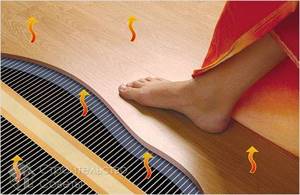
Heating systems called “warm floors” are one of the types of infrared heating, widely used in the private sector.
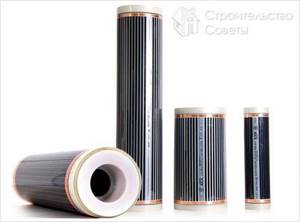
Elements of heating systems of this type are produced, as a rule, in film form and can be installed under any type of synthetic and wooden coverings. In addition, they are easily installed under various tile coverings and composite-based materials.
Method 7 - infrared heaters (the most economical)
Infrared heaters are considered the most economical of all types of electric heaters. They do not need heating elements and water pipes. Infrared heaters heat objects, not the room. Then the heated objects heat up the air. If an electric boiler can be compared to a kettle, then an infrared boiler can be compared to a microwave oven.
Infrared panels are especially popular. They are installed on the ceiling or walls of residential and industrial premises. Since the heating area is increased, the room becomes warmer faster than usual. Such a panel can be used as an independent heating source or as an addition to an existing system. An infrared heater goes well with electrode boilers. For example, an infrared heater can only be turned on in spring and autumn, when it is too early to turn on the main heating, or when it suddenly gets cold outside.
Pictured is a GROHE infrared panel, Germany
Date: September 25, 2021

